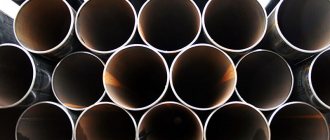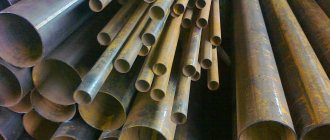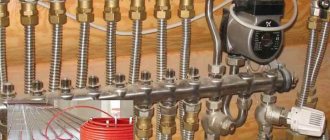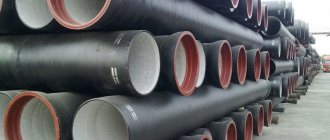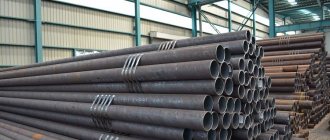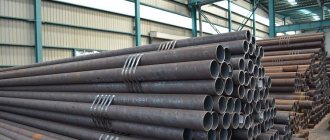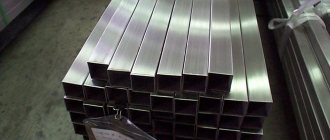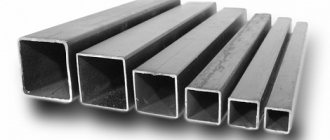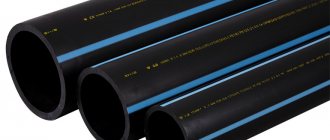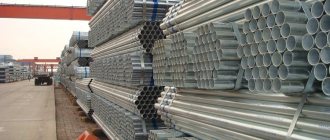Steel water pipes are still widely popular today, since steel water pipes have a long service life and are practically not subject to damage caused by mechanical stress. For long-term use of a steel water supply system, it is necessary to select the correct pipe type and diameter, and also install the system in accordance with all requirements.
Steel pipes for water supply installations
Classification and characteristics of steel pipes according to GOST
Compliance of system elements with regulatory requirements guarantees a long service life of the pipeline. High-quality steel pipes in Nizhny Novgorod can be used in the installation of open and closed pipelines for various purposes. Such products can be divided into types depending on size and production method.
Pipe classification
Rolled steel is usually divided into types, depending on:
- Cross-sectional shapes. They can be not only round, but also oval, square, segmented, with a different number of edges, and others.
- Outer diameter values. Medium steel pipes include rolled steel pipes, the diameter of which is in the range of 102 – 426 mm. If the parameter is greater, the rolled metal product is considered large, less - small.
- Lengths. Regulatory documents require the production of rolled steel of measured, multiple measured or unmeasured lengths.
- Class. First class rolled metal is supplied without burrs and with cut edges. The second class involves only cutting into pipes of the required length.
The method of producing steel products allows us to divide into:
- Electric welded, which can be straight-seam or spiral-seam depending on the position of the weld relative to the axis of the product. In the first case, the weld seam is parallel to the pipe axis, in the second case it is located in a spiral,
- Seamless, manufactured at different heating temperatures. They can be hot-deformed and cold-deformed.
If steel pipes are intended for use in special conditions, they are often supplied with an anti-corrosion coating. Rolled products can be coated with a layer of zinc, extruded polyethylene and other compounds.
Main characteristics
Regulatory documents regulate the characteristics of steel pipes depending on the manufacturing features. The main characteristics include:
- Outside diameter. It varies widely and depends on the method of production of a particular product.
- Inner diameter.
- Wall thickness. Manufacturers offer thin-walled and thick-walled products. The parameter depends on the ratio of the outer diameter to the wall thickness. Thin-walled rolled products are considered to be those in which this ratio does not exceed 12.5 – 40 or the wall thickness does not exceed 1.5 mm.
- Rolled steel length. Measurement is regulated by regulatory requirements. It is possible to supply rolled metal, the length of which is a multiple of the standard value or is unmeasured.
Thus, the main characteristics of electric welded products are established by GOST 1050. More detailed information on longitudinally welded products is presented in GOST 10704 - 10706, on spiral welded products - in GOST 20295. Requirements for square rolled products are established by GOST 8639, and for rectangular rolled products - GOST 8645.
Based on the technical characteristics of a particular steel pipe, its service life, possible operating temperature conditions, operating temperature and pressure are determined.
Classification and characteristics of steel pipes according to GOST
Compliance of system elements with regulatory requirements guarantees a long service life of the pipeline. High-quality steel pipes in Nizhny Novgorod
Is it possible to use galvanized chimney?
Galvanized steel is successfully used for arranging chimney circuits. However, some properties of galvanizing, namely toxicity when heated and instability to extremely high temperatures, somewhat limit the scope of its use as a chimney.
Harm
It is important to remember that when heated above 419.5⁰C, zinc begins to release metal oxide fumes that are toxic to humans. The greatest danger is posed by the so-called technical zinc, during the production of which even more harmful lead, arsenic and antimony are added.
Therefore, galvanized chimneys are prohibited from being installed in systems with a heating temperature of more than 350⁰C, which means they are not suitable for heat generators running on coal or wood. But in symbiosis with a heating unit running on gas or diesel fuel, galvanized chimneys are quite safe.
Life time
The “life” period of a galvanized chimney depends on a number of factors:
Wall thickness, which must be at least 1 mm. At lower rates, the pipe burns out already in the first or second heating season.
Buildings. Single-walled ones, as a rule, require replacement after a couple of years, while double-walled (double-circuit) ones can last about 45 years.
The presence of a thermal insulation circuit. Without insulation, harmful condensation forms in the pipe and soot begins to accumulate, which increases the risk of a chimney fire and reduces its service life by at least 3 times.
Expert opinions on the technology for creating steel pipes
Industry leaders, as well as specialists with many years of experience, commented on the technology for manufacturing tubular products.
Head of technical support of the Adelant group A.A. Nazimov:
“The recommended temperature range for optimal creation of high-quality products should ideally be down to -10 degrees Celsius. The most profitable metal for smelting is copper, since it belongs to the rich group of non-ferrous metals. To successfully secure pipes, it is necessary that their fastenings direct the extensions towards the seams.”
Executive Director of the National Copper Center NP V.S. Ionov:
“Pipes should not lie in warehouses like dead weight. To comply with the measures and achieve good shape before selling, several conditions must be met:
- It is necessary to use a canopy against the influence of oxygen, which impairs the strength of the structure.
- The storage location should be completely straight, without sharp corners.
- Do not store pointed objects together with pipes.
- You only need to remove the canopy before installation.
All these factors together will save enterprises from possible losses.”
Scientists S.M. Guriev and K.O Sonin about the impact of the resource curse on steel production:
“Strengthening the role of local sources of raw materials, instead of exploiting mineral resources, will bear fruit in the social circle of consumption, making all goods more accessible to the general public. The income of large and partly small manufactories will increase, the industry of states will go up. The other side of the coin is that a complete rejection of traditional materials will lead to the massive development of the Dutch scenario, when, due to the enormous growth of one sector of the state system, the rest will decline. Perhaps the conveyor belt will go uphill, allowing the powers to save money, but this will worsen the social security of people and the government budget. All these factors together will not allow the chemical industry to displace traditional raw materials, since not a single political party in power will allow this gambit to be used.”
Warehouse complex
How to choose the size of plastic water pipes
If you are faced with the need to replace the plumbing system in your apartment, then you will have to purchase suitable parts - pipes and fittings. After the difficult question of choosing a material, the main thing you have to think about is the size of the water supply elements.
Characteristics that determine the size of pipes for water supply
When talking about pipe sizes, we usually mean a combination of the following parameters.
External diameter - usually specified by the manufacturer. Internal diameter is an important characteristic for parts of a plumbing system, measured in inches. It should not be different for pipes and fittings connected to each other. Nominal diameter (DN) - is a nominal value that is used when installing all parts of the water supply system
It is an averaged parameter, close in value to the diameter of the lumen. Product wall thickness. Length of the product.
Pipe diameter matching
Quite often, plumbing is a combined system that includes elements from different materials. Difficulties can arise here, since the diameter of steel structures is indicated in inches, and plastic products - in millimeters. In order to correctly select the required sizes, you can use specially designed tables. If you need to connect the steel part of the water supply with plastic elements, then the table of correspondence between the diameters of steel and plastic products will help you.
1 inch corresponds to 25.4 millimeters.
Water supply capacity
The diameter of water supply pipes has a direct connection with such a concept as throughput. It is determined by the passage of a certain volume of water over a certain period of time. For example, a pipe with a clearance of 25 millimeters can pass through a volume of water reaching 30 liters in a minute.
Throughput is taken into account when calculating the dimensions of parts of the plumbing system and fluid pressure. It can be defined in three ways:
- Using formulas that use measurements of system parameters. Such calculations are quite complex, so only specialists use them.
- Using tables for a specific type of material.
- Using programs designed to optimize plumbing systems.
You need to know this: one of the advantages of plastic pipes, unlike steel or cast iron, is that the throughput value remains unchanged throughout its entire service life.
Selecting the diameter of plastic pipes
The optimal size of the elements of the plumbing system depends on many factors:
- length of the water pipeline,
- number of connections and joints,
- number of turns,
- number of water intake points,
- water pressure in a particular system.
The good news for non-professionals installing their own water supply system is the opportunity to abandon complex calculations and use standard solutions.
- for systems with a length not exceeding 10 m, pipes with a clearance of 20 mm are more often used,
- for 10-30 meter systems, products of 25 mm diameter are usually taken,
- lengths greater than 30 meters require the use of a 32mm diameter.
If we are talking about intra-apartment wiring, then everything is much simpler. Since the water supply in the apartment is short, in most cases products with the following internal diameters are suitable:
- 15 mm or half inch,
- 10 mm or 3/8 inch.
The following dimensions are chosen for the riser:
- 20 mm or 3/4 inch,
- 25 mm or 1 inch.
A larger diameter may be needed in the following cases:
- If the water supply system has a complex structure, has a large number of turns, joints and is characterized by variable pressure,
- If water is constantly used in large quantities.
What are the consequences of choosing the wrong pipe size?
If the installed plumbing system components are of the wrong diameter, this can cause the following problems:
- Increased pressure in the system will create additional stress, leading to accelerated wear and an increased likelihood of breakthroughs and breakdowns.
- The water in the pipes will make noise - the humming is also caused by the discharge pressure.
- A significant reduction in pressure when drawing water at one of the points - for example, when you turn on the shower in the bathroom, water from the tap in the kitchen will flow in a thin stream.
How to choose the size of plastic water pipes Dimensions of plastic pipes for water supply
Is it important to consider their size when choosing pipes? How to calculate the capacity of a water supply system?
Briefly about the main thing
It is not difficult to choose a material for installing a water supply system if you know all the features of pipes, methods of their assembly and changes in characteristics under different operating conditions. For example, if you need to choose which pipes are best for underground water supply in a private house, then HDPE or PP pipes would be the ideal solution. All types of plastic and metal-plastic products are suitable for internal wiring, with the exception of pipes made of low-density polyethylene, as well as copper ones. Traditional steel pipes can also be used, but you need to be prepared that hard water will quickly damage them, and their appearance will have to be maintained by regular painting.
Ratings 0
We weigh the pros and cons
But let’s not be unproven and move on specifically to the pros and cons of this product:
Advantages
- Steel water pipes in accordance with GOST 10704 91 are highly resistant to mechanical loads. This is the most durable material used in plumbing, so if you need to lay pipelines under the floor, under the roadway, under conditions of high internal pressure, or in even more extreme environments, then steel products are the best choice.
- Relatively low price. Of course, a pipeline made from this material will not be the most inexpensive, but it can be fully called one of the most economical. Moreover, the accessibility factor also comes into play here. Since if you need to lay a small section of water supply, then by chance you will not have a metal-plastic bay on the site, but a steel section may be found in full.
- Wide range of auxiliary fittings. Iron corners, tees, adapters and other parts necessary for an optimal water supply system are invariably abundant on the shelves of specialized stores.
- Low thermal expansion rate. This is a very important parameter for pipes if you plan to hide them in screed or plaster, since if it is high, this will lead to rapid cracking of the coating layer.
- High resistance to temperature changes. The steel pipeline will withstand all possible temperatures in domestic conditions, which allows it to be safely installed to supply warm water or to a heating system.
Flaws
Let's be objective and immediately consider all the disadvantages that accompany the operation of the products under consideration:
- Susceptibility to corrosive processes. Rust destroys metal, especially in cold water supply lines, where condensation quite often forms on the surface of the iron due to the temperature difference with the outside atmosphere.
- Reducing the internal diameter. Over time, growths accumulate, blocking the passage, which also does not occur without the participation of corrosion processes.
- Complicated instructions for performing installation work. You will either need the services of a welder, or you will need to cut the threads using dies. Both options are time-consuming and expensive, but we will look at them in more detail.
- Enormous weight. Significantly complicates the transportation and installation of pipes. In addition, excessive heaviness requires reliable fastenings when fixed to the wall and puts additional stress on the foundation.
Traditional solution
Since people began to use pressure water pipes and special pumps designed to increase flow pressure, steel products have not lost their popularity to this day, despite the abundance of other more modern materials.
Currently, in every building materials supermarket, metal water pipes occupy a significant part of the shelves. Obviously, such popularity is associated with the advantages of these products, which pipes made from other materials cannot compete with.
Types of steel pipes, based on manufacturing method
Despite the lack of demand, the market offers a wide variety of product options. The vector of their application is the laying of water pressure systems and sewers. For trade communications, pipes play an important role, since they transport the most in-demand resources - oil and natural gas. The reason for the gradual abandonment of their use is instability to corrosion - after a few years, most of them become faulty, which forces them to constantly purchase extra copies just to ensure a surplus of stocks.
On the one hand, problems with rust are solved with special coatings, which, by the standards of the budgets of consumer corporations, do not represent large expenses. On the other hand, many kilometers of transport routes will not allow timely monitoring of each problem area, which, naturally, will cause problems.
Classification of steel pipes by production models:
Electric-welded pipes
Electric-welded: straight-seam and spiral-seam manufacturing techniques are used for their production. The use of electric welding equipment, based on soldering molecules with a crystal lattice that have a covalent polar bond, helps to achieve the desired shape and properties. Perfect machine work under the guidance of an experienced craftsman creates a thick layer of steel with a characteristic low, smooth seam. This type is used in water-pressure systems for intercity and intracity communication, as well as for the transportation of natural gas.
Important!
Electrically welded pipes cannot be used in sewers in mass quantities due to the material's vulnerability to extreme moisture.
Regulation of thickness and volumes is carried out in accordance with GOST 10704-91:
| Outside diameter | Theoretical mass of pipes taking into account wall thickness | |||||||
| 0.823 | 0.912 | 1.001 | 1.234 | 1.433 | 1.677 | 1.829 | 2 | |
| 10 | — | — | 0.234 | 0.259 | — | — | — | — |
| 12 | 0.201 | 0.238 | 0.267 | 0.298 | 0.321 | 0.411 | — | — |
| 14 | 0.255 | 0.288 | 0.312 | 0.360 | 0.429 | 0.493 | — | — |
| 16 | 0.321 | 0.340 | 0.360 | 0.443 | 0.501 | 0.540 | 0.603 | 0.732 |
| 18 | 0.346 | 0.376 | 0.390 | 0.470 | 0.581 | 0.598 | 0.641 | 0.750 |
| 20 | 0.370 | 0.398 | 0.400 | 0.497 | 0.588 | 0.632 | 0.699 | 0.789 |
Spiral welded: mass rolled steel, unlike the previous type, combines thick sheets of material with a minimally thin seam. That is why the breadth of application is quite small in domestic consumption, since this design is not capable of withstanding high temperatures. They are used to heat buildings and supply water pressure to residential buildings.
Worth paying attention:
Spiral welded pipes can only be used in domestic and general consumer circles (schools, homes, universities, and so on). They are not suitable for technical use, since the too thin seam cannot withstand high temperatures.
Spiral welded steel pipes
The size ratio is regulated by GOST 8696-74:
| Outside diameter | Casting density at wall thickness | ||||||
| 3.65 | 4.04 | 5.33 | 6.08 | 7.44 | 8.22 | 9.04 | |
| 158 | 14.23 | 16.34 | — | — | — | — | — |
| 224 | — | 23.04 | 28.45 | — | — | — | — |
| 287 | — | 26.98 | 33.42 | — | — | — | — |
| 341 | — | 29.09 | 36.56 | 49.21 | — | — | — |
| 388 | — | 32.01 | 38.5 | 56.45 | — | — | — |
Seamless: made from special materials using hot and cold fusion technology.
They do not have seams; their quality is an additional cover that appears when metals are soldered. GOST regulates several key parameters by regulations 8732-38 and 8734-75:
| Outside diameter | Weight 1m with pipe thickness | ||||||
| 2.55 | 3.111 | 3.566 | 4.098 | 4.656 | 5.208 | 5.777 | |
| 20.3 | 1.098 | 1.099 | 1.112 | 1.131 | — | — | — |
| 21.6 | 1.19 | 1.21 | 1.243 | 1.378 | — | — | — |
| 22.898 | 1.27 | 1.29 | 1.339 | 1.467 | — | — | — |
| 25.454 | 1.39 | 1.442 | 1.545 | 1.689 | 1.745 | 2.345 | 2.678 |
| 26.777 | 1.56 | 1.588 | 1.701 | 1.798 | 1.910 | 2.556 | 3.002 |
Seamless stainless steel pipes
Interesting fact:
GOST is responsible only for products whose diameter does not exceed 250mm.
What to look for when purchasing?
If you decide to do the plumbing installation yourself, always consider the following factors:
- reliability;
- ease of installation;
- the cost of pipes, fittings and additional equipment that will be required for installation.
It is worth paying special attention to the manufacturer. The modern market offers products from domestic and imported companies, so making a choice can be difficult.
- It is believed that the best products are produced by European companies.
- Turkish products have certain disadvantages, but they are inexpensive and quite reliable.
- When choosing Chinese pipes, you need to be prepared for anything, since reviews of such products are very contradictory.
- Domestic companies often offer good options. Such equipment has good technical characteristics and an affordable price.
Download GOST 10704-91 in PDF and what you need to know about it
The standard was developed in 1991, but it was not introduced into common practice until 1993. The changes made to it concerned mainly the assortment, dimensions and technical characteristics.
Electric-welded galvanized steel pipe DU65 is an extremely popular product. If it is used at any national economic facility, then all work will be focused on the content of GOST 10704.
Stainless steel
Perhaps some construction organization has already used this product several years ago. But emerging new technologies are immediately reflected in GOSTs.
Attention!
You cannot start a new cycle of work without familiarizing yourself with the current amendments that have been added to the standard. You need to know about them “before” and not “after” the start of work.
As a rule, all technical nuances are grouped and released in the form of a separate application. But sometimes innovations are introduced directly into the text. In this case, the publication must be accompanied by special informative notes.
If you do not take into account all the amendments in time, then there is a high risk of working with information that has lost its relevance.
Why is the information reflected in GOST important? It contains basic data: a list of standard sizes, permitted deviations, and so on. The technical requirements for production are reflected in 10705-80 and 10706-76. These include: mechanical properties, steel grade used in manufacturing, etc.
Moreover, all technical requirements must necessarily correspond to the standards of standard 10704. Therefore, before starting any construction, installation or restoration work, a thorough study of all the above-mentioned GOSTs is necessary.
These three standards constantly reference each other. The fact is that the basic characteristics of the final product are often determined by what technical conditions are prescribed for its manufacture.
Connection options
The last point worth highlighting is the available connection options. They can be:
- welded (only for rolled steel),
- soldered (for copper and plastic),
- threaded,
- press
The only option that can be easily dismantled and replaced is a threaded connection. However, it cannot be used when concreting in walls or floors, that is, the pipeline fittings must remain open.
Outside diameter
The purpose of this physical quantity is entirely to determine the characteristics of stability and durability. Absolutely all steel pipes are regulated according to it, and the proportions of other types of diameters are also established. Therefore, it can be argued that the outer diameter is the starting point for the design of highways.
Depending on the size and thickness, which are fully regulated by GOST, the classification is made into the following groups:
- Small specimens - used for heating residential buildings and buildings.
- Medium types are needed for laying urban water networks and supplying oil from sources to warehouses.
- Large categories - the creation of interregional and international highway systems for the transport of oil and natural gas in large quantities in different directions.
The framework by which the boundaries between pipe sizes are established is established by GOST:
| Small | Average | Large |
| 11 | 104 | 431 |
| 103 | 430 | 1500 |
To know the exact dimensions and thickness of pipes needed for operation in certain areas of consumption, you need to focus on the summary table presented below:
| Scope of application | Diameter |
| Residential buildings | 16-33 |
| Residential buildings | |
| Construction of sewerage systems | 52-104 |
| Transportation of natural resources | 433-1250 |
Important:
when calculating the required range, it is necessary to take into account the cross-section of the pipes, otherwise the outer walls may not withstand the pressure and crack or become damaged.
What are the varieties?
Pipes of this type are manufactured using several technological methods.
Products are:
- seamless;
- boiler rooms;
- electric welded;
- profile.
Each listed type of high-pressure product is subject to serious technological requirements. They are spelled out in a number of documents.
These include such state standards:
- GOST 3262 75;
- GOST 8696 74;
- GOST 20295 85;
- GOST 10705 80;
- GOST GOST 10706 80;
- GOST 11017 80.
The products in question undergo additional processing before being sent for sale.
First of all, it is coated with an anti-corrosion coating (galvanization). Some varieties are coated with insulating materials. Such as varnish, paint or polymer coating. The production process method is:
- Welded. It is carried out by bending sheet metal and welding it along the length of the joint.
- Seamless. The manufacturing process is carried out by pressing. For this purpose, a steel billet is rolled.
- Cast. It is made by casting metal on a special machine.
Welded structures are produced in two ways: electric welded and cold-deformed.
Low carbon steel is often used as a raw material. Seamless high-pressure pipes are made using hot or cold rollers. It is this type of product that is most in demand on the market.
